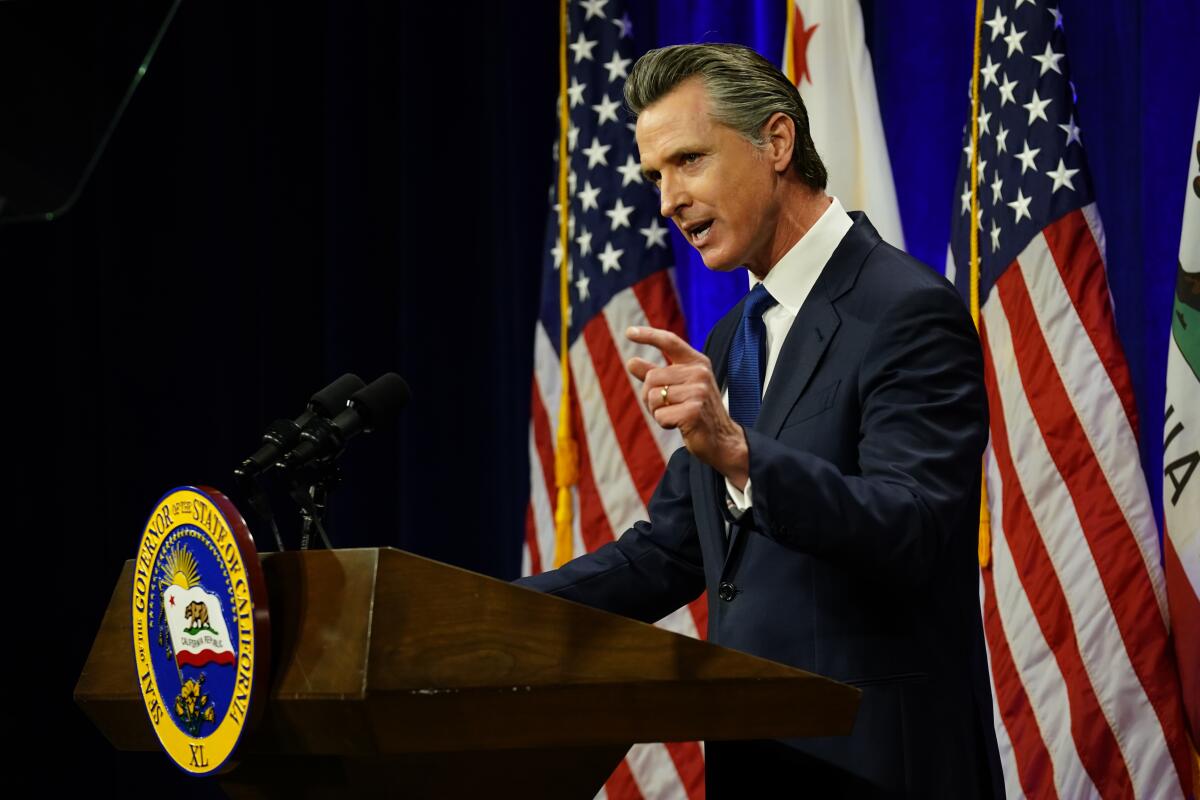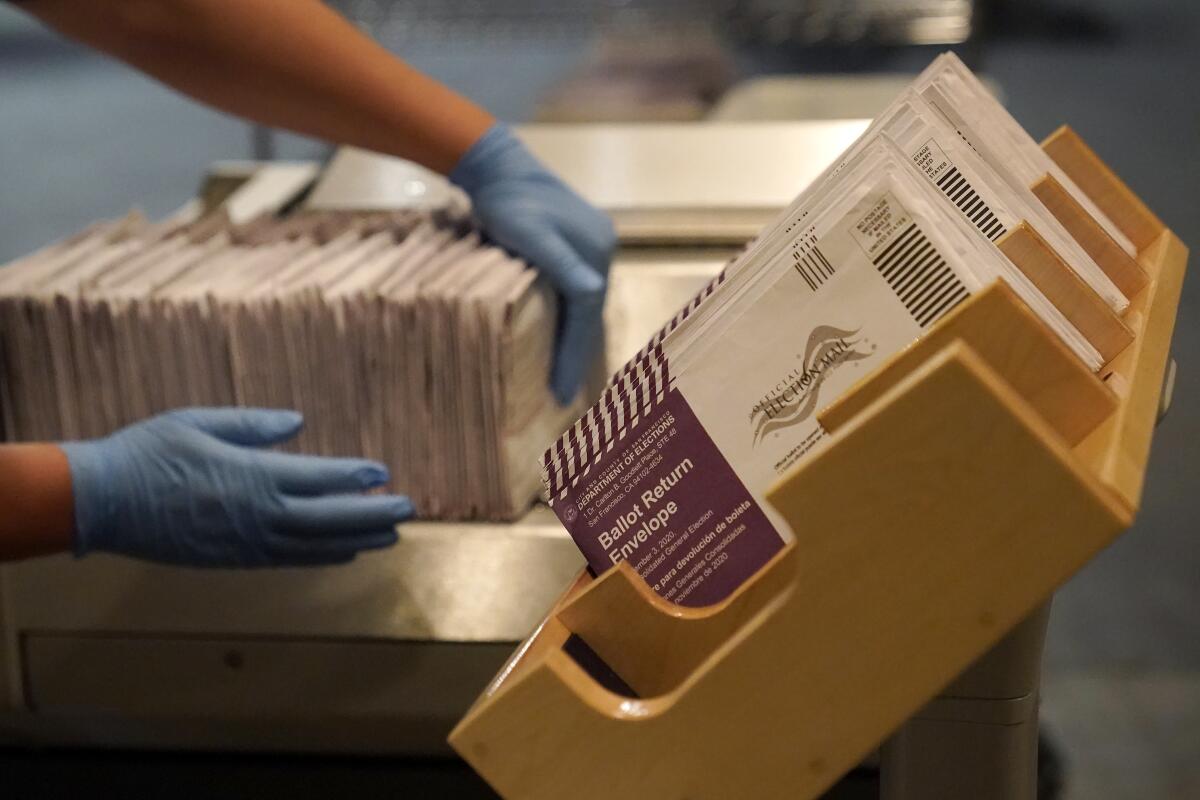California Politics: The elusive details about Newsom’s promises

- Share via
It’s been a whirlwind few days of sweeping political promises made by Gov. Gavin Newsom.
Twice in less than a week, Newsom vowed to tackle problems felt by millions of Californians — first pledging a new focus on some of the most difficult issues in the homelessness crisis, and then promising to lessen the pain the state’s drivers are feeling from the recent sharp spike in gas prices.
There’s little the two policy topics have in common except, perhaps, for this: Newsom’s plans for both are a major work in progress and are largely a marker for something to happen in the weeks and months ahead. But their to-be-determined status wasn’t immediately clear in the early days of coverage in the news and on social media.
Both pledges present big challenges to the governor and legislative leaders. And one key question going forward is whether the public has the patience for it all to get worked out.
Understanding Newsom’s ‘Care Court’ plan on homelessness
“Getting people off the streets and out of tents and into housing and treatment is essential, clearly essential, to making our streets safe for everyone,” Newsom said during his State of the State address Tuesday.
His latest effort — a combination of legal and clinical intervention for those with severe psychiatric disorders — could prove profound in California’s approach to homelessness. It would come, of course, on the heels of a $12-billion program launched last year and a $2-billion proposal unveiled in January as part of his state budget.
But in the week that followed, there have been no new details beyond a few basics: Newsom wants to create a civil court process in which people in need can be paired with legal representation and psychiatric professionals for a course of treatment that can last up to two years.
“The framework provides individuals with a clinically appropriate, community-based set of services and supports that are culturally and linguistically competent,” according to a three-page memo quietly posted online this week by the California Health and Human Services Agency.
So what would it cost? The program appears to require a sizable expansion of the state’s judiciary and, at least in broad terms, a need to think about how civil court judges would handle issues that might historically have had more of a connection to criminal proceedings. But would the program also require more funding on the local level? There are some concerns among local government officials and those involved in social services that Newsom’s plan might hinge on simply reallocating existing resources — spreading thin the funds that are already used to help vulnerable Californians.
We also don’t know what percentage of California’s homeless population might be helped by the governor’s “Care Court” plan, an essential bit of information to weigh the relative bang for the buck. And because many of the existing services are provided through counties, it’s unclear what relationship there will be with cities across the state when it comes to deciding who does what.
So far, there’s no word on when a proposal might formally be introduced in the Legislature. And it remains to be seen whether it will be tucked inside budget negotiations later this year.
Who would get gas price relief?
The only real news, it seemed, out of Newsom’s State of the State — a speech that reminded some state Capitol observers of how the annual event has lost much of its onetime luster — was his promise to Californians that the state will offset some the sudden rise in prices at the gas pump.
“In January, we proposed a pause for the gas tax increase,” the governor said. “Now it’s clear we have to go farther. And that’s why — working with legislative leadership — I’ll be submitting a proposal to put money back in the pockets of Californians to address rising gas prices.”
Those 45 words remain all that’s known about what might come next.
It’s likely that the politics of what happens next will be intense among both Newsom’s critics and his Democratic Party allies. The governor’s top economic advisor, Dee Dee Myers, told reporters Tuesday that the goal would be to direct “billions” in cash assistance to Californians who own a car. But administration officials later suggested the details weren’t quite so clear just yet.
And other questions will arise: what about a driver who isn’t the car’s legal owner? And should all drivers receive the same benefit, regardless of their income? Might drivers of fuel-efficient cars feel as though they are, in effect, subsidizing gas-guzzling vehicles if the effort focuses on the cost per gallon?
Last month, the independent Legislative Analyst’s Office also voiced skepticism about Newsom’s January proposal to cancel the planned summer increase in California’s gas excise tax. The analysts’ report noted that “lower fuel taxes — and the lower fuel prices that would result — likely would lead to higher fuel consumption, which in turn could lead to higher greenhouse gas (GHG) emissions and other forms of pollution.”
And how much of a money-back effort would it really take to make a difference? Last month’s LAO report included a sobering statistic: A one-cent reduction in California’s gas excise tax would lower transportation funding by about $175 million.

The impacts of all-mail elections
California’s historic move to mail a ballot to every active voter in 2020 led to a sizable increase in electoral participation, but also some concerns for a few of the impacts for traditionally underrepresented voters, according to a new study on Tuesday from a group of election researchers.
The report offers a glimpse at both expected and unexpected effects of the focus on more absentee voting and less in-person participation. Newsom signed a bill last year making the election change permanent.
In general, the researchers found the 2020 elections saw a more narrow gap in turnout between white and Black voters as well as between older and younger voters. But the report offers a cautionary tale when it comes to efforts that link more all-mail ballots with fewer in-person voting locations. A growing number of California counties have been making the change under a 2016 election law under which participation is optional. Additional counties consolidated their in-person voting in 2020 under temporary pandemic rules allowed by the state.
The impact, according to the report, was a wider gap in turnout among white voters, Black voters and Latino voters.
“The change appears to place an undue burden on communities of color,” the researchers wrote.
One other takeaway from the study, given the campaign season now on the horizon: California voters’ lack of interest in primary elections is even deeper among the non-white electorate, and state and local officials should step up their outreach in those communities.
“Without such targeting, neutral reforms that encourage more voting may unintentionally expand the turnout gap in such low-turnout contests,” the researchers wrote.
Enjoying this newsletter? Consider subscribing to the Los Angeles Times
Your support helps us deliver the news that matters most. Become a subscriber.
California politics lightning round
— As California Democrats work to motivate their voters ahead of midterm elections, their annual convention devolved into a showcase of division.
— House Speaker Nancy Pelosi endorsed her “colleague and friend” Rep. Karen Bass in the Los Angeles mayor’s race this week.
— County offices in charge of administering monthly food benefits to low-income Californians are understaffed and overwhelmed, leading to delays in services as the state stalls a promised boost in funding for the CalFresh assistance program.
— Nearly a year after Proposition 19 took effect, L.A. County officials have not completed any of the 1,271 applications they have received to recalculate the property taxes for older and disabled homeowners under the law.
— House flippers in the Golden State could be taxed 25% of their profit under a bill introduced on Thursday by a San Diego Democrat.
Stay in touch
Did someone forward you this? Sign up here to get California Politics in your inbox.
Until next time, send your comments, suggestions and news tips to politics@latimes.com.
Sign up for Essential California
The most important California stories and recommendations in your inbox every morning.
You may occasionally receive promotional content from the Los Angeles Times.







